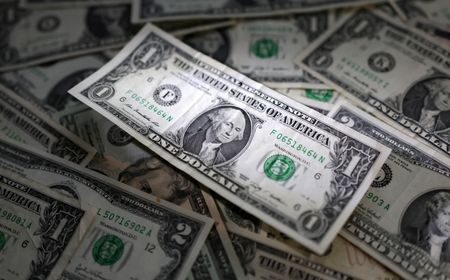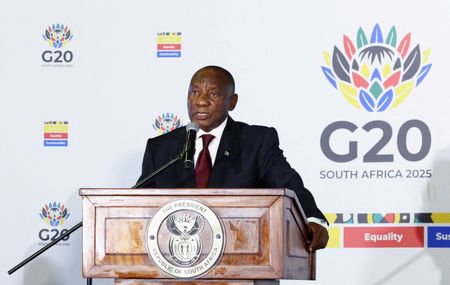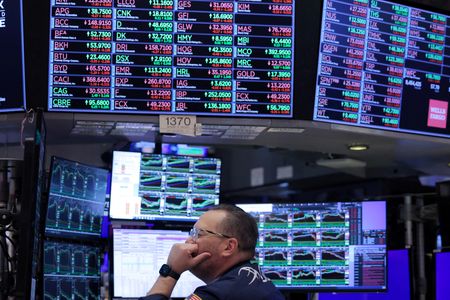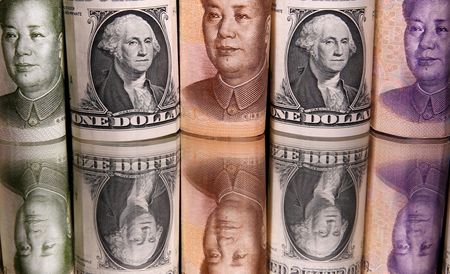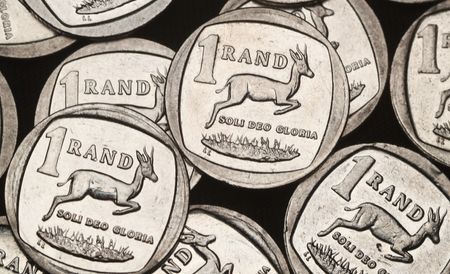By Rae Wee
SINGAPORE (Reuters) -A rebound in the dollar proved short-lived on Tuesday following renewed signs of strains in U.S.-China trade relations, which dented risk sentiment and left investors ducking for cover in traditional safe havens like the yen and the Swiss franc.
Just as markets found some reprieve after U.S. President Donald Trump struck a more conciliatory tone against tariffs on China, and on signs that a meeting with his Chinese counterpart was on track for later this month, developments on Tuesday served as a stark reminder that ties between the two nations remain on thin ice.
Beijing announced that it has taken countermeasures against five U.S.-linked subsidiaries of South Korean shipbuilding firm Hanwha Ocean and separately said it has launched an investigation into how a U.S. Section 301 probe affects its domestic shipping industry.
Adding to tensions, the United States and China on Tuesday will begin charging additional port fees on ocean shipping firms that move everything from holiday toys to crude oil.
All that sent the dollar sliding broadly, reversing its gains from earlier in the session.
The euro edged 0.14% higher against a weaker greenback to $1.1585, while sterling was up 0.12% to $1.3351.
The Australian dollar, often used as a proxy for risk appetite, suffered heavy losses to last trade 0.63% lower at $0.6475. The New Zealand dollar fell 0.5% to $0.5697.
“Beijing has been quite clear, they want negotiations and they want a relationship that’s based on mutual respect and something that’s going to be driven by a fair basis,” said Vishnu Varathan, Mizuho’s head of macro research for Asia ex-Japan.
“There’s a clear case to be made that this is not going to end just because parties have met to speak, because the underlying source of tensions… cannot be resolved until and unless someone concedes far more than they’re willing to.
“This U.S.-China state of affairs is not a cyclical thing. It’s a structural feature of the new geoeconomic realities, and that’s just what it is.”
China’s commerce ministry also said on Tuesday that it had informed the U.S. about the rare earth export controls Beijing announced last week prior to their introduction, adding that working-level talks between the two sides took place on Monday.
Safe-haven currencies like the yen and the Swiss franc meanwhile made steady gains.
Against the dollar, the Swissie was up 0.2% to 0.8027, while the yen reversed early losses to stand 0.3% higher at 151.86.
Still, lingering political uncertainty in Japan capped the yen’s gains, after Sanae Takaichi’s bid to become the nation’s first female prime minister was thrown into doubt on Friday when her ruling party’s junior coalition partner quit.
While the move halted the currency’s steep slide as investors assessed the chances of huge fiscal largesse under the new premiership, it continues to languish near eight-month lows.
“If you ask me, given the current interest rate differential between the U.S. and Japan, which should be the primary driver of the exchange rate as well, dollar/yen should not be at 152, so I do expect this trend to reverse pretty soon,” said Nigel Foo, head of Asian fixed income at First Sentier Investors, who expects the yen to strengthen eventually.
Elsewhere, cryptocurrencies were similarly caught in the broad selloff in risk assets, with bitcoin slumping 2.7% to $112,714.58. Ether tumbled 4.9% to $4,077.79.
Market participants said the crypto sector on Friday saw more than $19 billion in liquidations across leveraged positions as panic selling and low liquidity triggered sharp swings.
(Reporting by Rae Wee; Editing by Shri Navaratnam and Kim Coghill)

